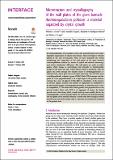Por favor, use este identificador para citar o enlazar a este item:
http://hdl.handle.net/10261/213863COMPARTIR / EXPORTAR:
 SHARE SHARE
 CORE
BASE CORE
BASE
|
|
| Visualizar otros formatos: MARC | Dublin Core | RDF | ORE | MODS | METS | DIDL | DATACITE | |

| Campo DC | Valor | Lengua/Idioma |
|---|---|---|
| dc.contributor.author | Checa, Antonio G. | es_ES |
| dc.contributor.author | González-Segura, Alicia | es_ES |
| dc.contributor.author | Rodríguez-Navarro, Alejandro B. | es_ES |
| dc.contributor.author | Lagos, Nelson A. | es_ES |
| dc.date.accessioned | 2020-06-09T09:47:01Z | - |
| dc.date.available | 2020-06-09T09:47:01Z | - |
| dc.date.issued | 2020-03-04 | - |
| dc.identifier.citation | Journal of the Royal Society Interface 17 (2020) | es_ES |
| dc.identifier.issn | 1742-5689 | - |
| dc.identifier.uri | http://hdl.handle.net/10261/213863 | - |
| dc.description.abstract | In biomineralization, it is essential to know the microstructural and crystallographic organization of natural hard tissues. This knowledge is virtually absent in the case of barnacles. Here, we have examined the crystal morphology and orientation of the wall plates of the giant barnacle Austromegabalanus psittacus by means of optical and electron microscopy, and electron backscatter diffraction. The wall plates are made of calcite grains, which change in morphology from irregular to rhombohedral, except for the radii and alae, where fibrous calcite is produced. Both the grains and fibres arrange into bundles made of crystallographically co-oriented units, which grow onto each other epitaxially. We call these areas crystallographically coherent regions (CCRs). Each CCR elongates and disposes its c-axis perpendicularly or at a high angle to the growth surfaces, whereas the a-axes of adjacent CCRs differ in orientation. In the absence of obvious organic matrices, this pattern of organization is interpreted to be produced by purely crystallographic processes. In particular, due to crystal competition, CCRs orient their fastest growth axes perpendicular to the growth surface. Since each CCR is an aggregate of grains, the fastest growth axis is that along which crystals stack up more rapidly, that is, the crystallographic c-axis in granular calcite. In summary, the material forming the wall plates of the studied barnacles is under very little biological control and the main role of the mantle cells is to provide the construction materials to the growth front. | es_ES |
| dc.description.sponsorship | This research was funded by projects CGL2017-85118-P (A.G.C., A.G.-S.) and CGL2015-64683-P (A.B.R.-N.) of the Spanish Ministerio de Ciencia e Innovación, the Unidad Científica de Excelencia UCE-PP2016-05 of the University of Granada (A.G.C., A.B.R.-N.) and the Research Group RNM363 of the Junta de Andalucía (A.G.C.). N.A.L., A.G.C. and A.B.R.-N. acknowledge support from CONICYT-Chile through grant nos. FONDECYT 1140938, PCI REDES 170106 and PIA ANILLOS ACT172037, for international collaborative research. | es_ES |
| dc.language.iso | eng | es_ES |
| dc.publisher | Royal Society (Great Britain) | es_ES |
| dc.relation | info:eu-repo/grantAgreement/AEI/Plan Estatal de Investigación Científica y Técnica y de Innovación 2017-2020/CGL2017-85118-P | es_ES |
| dc.relation | info:eu-repo/grantAgreement/MINECO/Plan Estatal de Investigación Científica y Técnica y de Innovación 2013-2016/CGL2015-64683-P | es_ES |
| dc.relation.isversionof | Publisher's version | es_ES |
| dc.rights | openAccess | es_ES |
| dc.title | Microstructure and crystallography of the wall plates of the giant barnacle Austromegabalanus psittacus: a material organized by crystal growth | es_ES |
| dc.type | artículo | es_ES |
| dc.identifier.doi | 10.1098/rsif.2019.0743 | - |
| dc.description.peerreviewed | Peer reviewed | es_ES |
| dc.relation.publisherversion | https://doi.org/10.1098/rsif.2019.0743 | es_ES |
| dc.identifier.e-issn | 1742-5662 | - |
| dc.rights.license | https://creativecommons.org/licenses/by/4.0/ | es_ES |
| dc.contributor.funder | Ministerio de Ciencia e Innovación (España) | es_ES |
| dc.contributor.funder | Ministerio de Economía y Competitividad (España) | es_ES |
| dc.contributor.funder | Universidad de Granada | es_ES |
| dc.contributor.funder | Junta de Andalucía | es_ES |
| dc.relation.csic | Sí | es_ES |
| oprm.item.hasRevision | no ko 0 false | * |
| dc.identifier.funder | http://dx.doi.org/10.13039/501100003329 | es_ES |
| dc.identifier.funder | http://dx.doi.org/10.13039/501100006393 | es_ES |
| dc.identifier.funder | http://dx.doi.org/10.13039/501100004837 | es_ES |
| dc.identifier.funder | http://dx.doi.org/10.13039/501100011011 | es_ES |
| dc.contributor.orcid | Checa, Antonio G. [/0000-0001-7873-7545] | es_ES |
| dc.identifier.pmid | 32126195 | - |
| dc.type.coar | http://purl.org/coar/resource_type/c_6501 | es_ES |
| item.fulltext | With Fulltext | - |
| item.languageiso639-1 | en | - |
| item.openairecristype | http://purl.org/coar/resource_type/c_18cf | - |
| item.openairetype | artículo | - |
| item.cerifentitytype | Publications | - |
| item.grantfulltext | open | - |
| Aparece en las colecciones: | (IACT) Artículos | |
Ficheros en este ítem:
| Fichero | Descripción | Tamaño | Formato | |
|---|---|---|---|---|
| Checa_JRoyalSoc_Interface17.pdf | Artículo principal | 4,71 MB | Adobe PDF |  Visualizar/Abrir |
CORE Recommender
PubMed Central
Citations
2
checked on 18-abr-2024
SCOPUSTM
Citations
6
checked on 19-abr-2024
WEB OF SCIENCETM
Citations
5
checked on 28-feb-2024
Page view(s)
113
checked on 24-abr-2024
Download(s)
193
checked on 24-abr-2024

